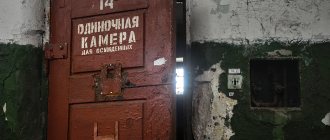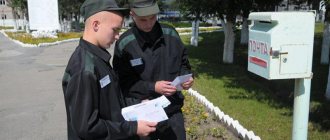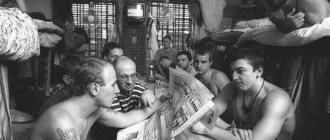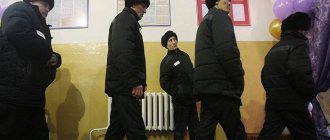OD 1/T-2 “Vladimir Central”
Mode: Prison
Number of places:
Head: Vladimir Mishchenkov
Address: Vladimir, st. B. Nizhegorodskaya, 67
Phone: 32-4539, 32-2033.
Description
At the moment, the main prison building still faces the same Bolshaya Moskovskaya street with its main windows - one of the most important and central in the city of Vladimir.
The facade of the prison is practically no different from the facades of neighboring buildings - a building stretching approximately 150 meters on two floors of an ancient building. Externally, it is a standard hospital in provincial cities.
The differences between the building and others begin immediately after the entrance. In the courtyard, rolled into asphalt and spacious in size, massive masonry buildings of the prison appear, which are limited along the entire perimeter by various posts with an innovative security and alarm system.
In total, on the territory of the Vladimir Central there are 4 buildings - 1 is a hospital building, and the remaining three are for holding prisoners there. The oldest of them is the “Polish” building, which got its name due to the fact that it housed Polish rebels who took part in the mass uprising that occurred in 1861.
Today, compared to the past, practically nothing has changed in the internal appearance of the prison. These are also durable windows, equipped with the same powerful bars, metal doors, which replaced oak ones. Walks of convicts and prisoners in custody take place in a courtyard with a ceiling with bars. Many believe that it was from the Vladimir Central that such an expression as “checkered sky” came from.
Over the two and a half centuries of the existence of the Vladimir Central, a lot of people have seen the checkered sky, from small thieves and fighters against the tsarist regime, to ideological opponents of the authorities, maniacs and rapists.
Now Vladimir Central has become a prison for the most dangerous criminals. These are rapists, murderers, repeat offenders, and many other lawbreakers.
It should be noted that now the regime in this prison has become more humane when compared with the regime that existed before - now it has become closer to generally accepted international standards. The cells have televisions, refrigerators, literature and much more.
Song and prison - who became more famous?
The author of “Vladimir Central” in modern publications is called “the king of Russian chanson”, “the most popular representative of the genre”, “the most famous performer”, but most importantly - the author of “the most popular song in this genre”, “a standard musical work created in the genre of prison romance."
Mikhail Krug (pseudonym of Mikhail Vorobyov, 1962–2002), a native of Tver, began his official career as a singer-songwriter in 1994, when his first album “Zhigan-Lemon” was released on disc. Even before the release, three amateur magnetic albums were recorded in the Tver Palace of Culture; there was no talk of any copyright at that time, and Krug’s songs were simply rewritten and quickly distributed throughout the city. In 1996, Krug performed for the first time in Moscow, at the Russian Chanson festival. “Vladimir Central” was released in 1998 on the fourth album of the Circle “Madame”. In total, he wrote more than 100 songs, but all those who are familiar with Vladimir Central are unlikely to know about this. The widest popularity of the song is evidenced by the presence of parody versions and memes.
The song is heard in the goblin translation of "The Lord of the Rings" in the episode "Pendalf in Sarumyan's Trap" part of "The Fellowship and the Ring". Counting on one hundred percent recognition of the text, alteration of the lines of the chorus “Prison Azkaban - the north wind. / A stage to Mordor - there is immeasurable evil” is used by Sergei Panarin in his parody book “Harry Proglotter and the Magic Shawarmatrix”. The KVN members did not ignore the song either. A school version of the song called “Vladimir Lyceum” was created by a group of Avtoradio presenters “Murzilki International”:
To find out whether there are people who know nothing about this song or about Krug as its author, we conducted a survey among Facebook users, in which 440 people took part. It turned out that 99.8% of all respondents know the composition, but only half know that its author is Mikhail Krug. Several people identified the song as folk.
Judging by the survey data, the song became a hit already in the year of its release: “I learned “Vladimir Central” in the spring and summer of 1998 - this year I graduated from school. It was a hit at the time, so at the graduation party the DJ played it twenty times at the request of graduates and parents. It was imprinted for the rest of my life. The only competition was “Oh, what a woman” and “How delightful the evenings are in Russia.”
The participants identified the peak of popularity of “Central” as the late 1990s - early 2000s; some claimed that they heard the song back in the early 1990s, which is completely impossible, but quite understandable: “Vladimir Central” in its theme and style has become a kind of sign those dashing years, and for some, even a common noun, with the help of which it is easy to describe the entire thieves or gopnik culture, strongly associated with the 90s of the twentieth century.
Our respondents' voluntary and involuntary acquaintance with the hit took place at school discos, where, according to their testimony, slow dances were performed to the song, or in restaurants, where it was often performed to order. Several people said that in their youth they themselves performed “Central” with a guitar, along with compositions by Tsoi and “Civil Defense,” or sang it in karaoke.
Most heard the song from the speakers of taxis, buses and music kiosks. That is, it was very popular in the early 2000s, and not only among fans of prison chanson. We have before us a case where the fame of a song not only outstrips the fame of its creator (which is not uncommon), but also penetrates into those social circles for which there is no predilection for this musical direction.
As for the competition for primacy in fame between the prison and the song, our survey suggests that, most likely, the song glorified the Vladimir prison throughout the country and popularized its name: until 1998, the combination “Vladimir Central” was quite rare, and later it became popular. There is no doubt that the Vladimir prison was famous in its own right, but it is hardly possible to compare it with the famous Crosses or Butyrka. But this was the case before the song appeared - now the Vladimir Central invariably ranks among the most famous prisons in Russia.
OD 1/1
Code name: OD 1/1;
Mode: general (female);
Number of seats: 1300;
Head: Nikolay Lapshin;
Address: 601395 Vladimir region, Sudogodsky district, Golovino village, st. Soviet - 50;
Phone: 36-6487.
Description
Correctional institution - women's general regime colony FBU IK No. 1 belongs to the Federal Penitentiary Service of Russia on the territory of the Vladimir region (formerly called the Vladimir women's colony OD-1/1). This institution was formed on the site of the colony, where, starting in 1937, both men and women served their sentences. But since the second half of the twentieth century, the colony has become exclusively female.
At the moment, the maximum number of prisoners that the colony can accommodate is 1,333 people; moreover, the correctional institution has a Children's Home for 50 people located and functioning properly.
According to official data, today there are approximately 1,100 female representatives of at least 18 different regions of Russia in the colony. About 855 of them are kept in normal conditions, and 245 in light conditions. 75% of women serving sentences are between 20 and 40 years old; 22% of women are between 40 and 55 years old; about 3% are girls under twenty years of age.
Crimes for which a sentence is served in a correctional colony are classified as grave and especially grave, such as: murder; robbery; hooliganism; theft; intentional infliction of grievous bodily harm; distribution of narcotic substances and others.
The main task for the administration of the institution is to create and maintain favorable conditions conducive to the correction of women serving sentences in a colony, as well as to protect their rights and interests, adjusted for psychobiological characteristics.
Despite all the measures taken by the administration to correct the behavior of convicts, there is information about frequent violations of the regime. According to statistical data, it is possible to draw up a typical portrait of violators: as a rule, they are women 20–30 years old; those who have not received basic general education; having more than one conviction before the age of 35; with an antisocial past.
The administration is not always able to cope with such situations with the help of disciplinary sanctions against violators, and it is not always possible to use more stringent methods of suppressing violations in accordance with the requirements of Art. 117 of the Penal Code of the Russian Federation, which prohibits the use of isolation wards and cells for women with children under three years of age staying in a mother and child home.
Preparing for life after release is an integral part of the administration's work. To solve this problem, employees of special social protection groups conduct psychological diagnostics of convicted women and identify problems with which they will then have to work. At the same time, women are provided not only with psychological assistance and support, but also legal, including legal: registration of identity documents; registration of social benefits, etc.
Since 2006, a comprehensive Social Rehabilitation Center for released women has been opened in the correctional institution. This Center occupies an entire floor in one of the adjacent buildings. Can accommodate 24 people. Includes: several modern bedrooms, an equipped kitchen, a home cinema, comfortable bathrooms, and a gym.
This institution often hosts open days, during which convicted women are visited by their relatives and friends.
Also on the territory of the colony is the Orthodox Church of St. Anastasia the Pattern Maker, in the construction of which the prisoners themselves took part on a voluntary basis.
Central Prison
It received the historical name “Vladimir Central” only in 1906. Central means central prison. Most of the names were given to it under the Bolsheviks. They did not destroy it, like the rebel revolutionary French did the Bastille. Central fit perfectly into the Soviet regime. In 1921, it received the name “Provincial Isolator for Special Purposes,” emphasizing its punitive role against political opponents.
Vladimir Central: facade overlooking Bolshaya Nizhegorodskaya
In February 1948, a resolution of the Council of Ministers of the USSR put everything in its place without omissions. “Vladimir Central” was included in the system of special camps and prisons, which were ordered to contain especially dangerous state criminals, spies, saboteurs, terrorists, Trotskyists, Mensheviks, Socialist Revolutionaries, anarchists, nationalists and white emigrants.
Prison buildings and paddy wagon
By that time, more than 30 years had passed since the revolution, half of which was under conditions of total terror, but, as it turned out, not all “enemies of the people” had turned into “camp dust.” The year 1937 clearly could not ignore the Vladimir Central, but the details of the events that took place within its walls were completely lost. There were no people or documents left. When the Germans approached Moscow in 1941, the prison was actively preparing for evacuation to Ivanovo. The archives were destroyed in a terrible hurry.
Vladimir Central: side view
The Germans still got into the central area. A group of captured German generals was sent there, whose release was negotiated by the first Chancellor of the Federal Republic of Germany, Adenauer. The Japanese prisoners were less fortunate. The generals of the Kwantung Army who found themselves in Vladimir all died out, unable to withstand the unusual climate and food. None of them returned to their homeland, and the bodies of the dead were buried in a cemetery located next to the prison.
OD 1/2
Code name: OD 1/2;
Mode: General;
Head: Alexey Kurochkin;
Address: Petushinsky district, Pokrov;
Phone: 33-1992, 23-8670.
Description
A multi-level fenced perimeter helps maintain isolation from the outside world. The perimeter is guarded from the outside from high-rise guard structures (towers), as well as from the territory and office premises. To exclude illegal actions and possible attempts to escape, additional telemetry systems have been installed and video surveillance equipment is widely used.
To correct prisoners, the following system is used: with conscientious and correct behavior, without criticism, the prisoner’s regime of detention is eased; in case of non-compliance with the regime, constant violations of the rules, insubordination, the regime is tightened.
If a prisoner demonstrates exemplary behavior for a long time and tries with all his might to improve, then he can be released early or transferred to a penal colony to serve the remaining sentence.
Men and women cannot live together on the territory of a correctional institution, even if there are several isolated perimeters.
OD 1/4
Code name: OD 1/4;
Mode: strict;
Number of seats: 1505.
Head: Nikolay Panevin;
Address: 601440, Vladimir region, Vyazniki, st. Zheleznodorozhnaya, 37;
Phone: 23-78-01, 23-32-06, 2-51-67, 9-52-35.
Description
The correctional institution called FBU IK No. 4, whose old name is OD 1/4, belongs to the Federal Penitentiary Service of Russia in the Vladimir region. The institution is a maximum security correctional colony.
The colony was formed in 1818 on the site of a one-story wooden building of the Vyaznikovsky city prison. Until 1957, the purpose of the prison did not change, after which, due to the reorganization of the Gulag, it turned into the Vyaznikovsky colony for convicts. Since 1961, based on the improved penal code, the institution acquired the status of a colony with a high security regime. At the moment, the colony is intended for persons who have committed particularly serious crimes.
Production base of the correctional institution:
- — Metalworking workshop;
- — Turning shop;
- — Woodworking shop;
- — Subsidiary farming (growing crops, raising animals);
- - Bakery.
A board of trustees operates on the basis of the correctional institution, which deals with various types of support for prisoners: issues of social rehabilitation of convicts; broadening their educational and cultural perspectives; provision of professional skills. The Council also provides financial support to convicts within the walls of a correctional colony.
On the territory of the correctional institution there is the Church of the Nativity of Christ, which is a symbol of faith and hope for those serving their sentences.
Of course, there are some problems. Some time ago, the relevant authorities began to receive complaints from prisoners regarding non-compliance with the necessary conditions of detention and violations of the rights of convicts. This circumstance served as the reason for inspections of this correctional institution by the Prosecutor General's Office of the Russian Federation. In particular, an on-site inspection was carried out, during which a number of violations were identified: non-compliance with the standards of medical, sanitary and material services; violations of the regime; fire safety violations; lack of educational work; violations of the rules for granting visits to prisoners, etc.
Who participated in the creation of the song
Despite the fact that people were surveyed whose musical tastes lie outside the direction defined as “Russian chanson” (and this was the intent of the survey), out of 440 people, 16 were familiar with one of the versions of its origin, namely, related to Sasha Sever (or Severny) - a Tver crime boss who served time in the Vladimir prison and with whom Mikhail Krug was well acquainted. The most famous legend about the design of the “Vladimir Central” is associated with his name.
The authors of the book “The Life and Death of Mikhail Krug,” most likely relying on an interview with Mikhail Krug, published in 2001, outline the history of the creation of the song as follows:
“In 1995, the Circle came to Vladimir, where at that time the Tver thief Alexander Severov was sitting. This means Sasha Severov, with whom Mikhail was on friendly terms. The circle came to see him on a date. <…> And after the meeting with Severov, this famous song was written.”
The legend says that instead of the hemistich “northern wind,” the original version sang the name of the legendary prisoner - Sasha Severny, but the crime boss asked Krug not to mention his name, and thus the image of the wind arose.
The same book, “The Life and Death of Mikhail Krug,” reports a mistake made by Krug:
“One of the most famous Tver criminals, who served a total of twenty years, notes that there are inaccuracies in the song. Firstly, prisoners were never delivered to the Vladimir Central Center “by train from Tver.” They were first taken to Moscow, usually to the transit prison on Krasnaya Presnya, and from there they were taken to the Vladimir “krytka”. And secondly, only a few Tver residents ended up in Vladimir, and not entire stages.”
There is another interpretation of the story about what role the Tver thief in law played in the appearance of the song. One of the participants in our survey reports that the song itself for the Circle “could have been written by the thief in law North.” This version most likely goes back to media materials. So, in 2012, the NTV channel aired a story entitled “Russia has been singing the wrong “Vladimir Central” for many years,” the main character of which was the same Alexander Severov (with exactly this variant of the name). The material is presented in the genre of investigative journalism, during which it turns out that the crime boss wrote several songs for a fellow chansonnier. The authorship of “Vladimir Central” is not directly stated; everything is structured in such a way that the viewer must draw exactly this conclusion. According to the program, the thief in law asked the performer not to mention his name and “gave him a few more lyrics, which Mikhail Krug performed along with his own songs.”
There is a lesser-known version with a plot of substituted authorship: the song, or rather its chorus, was whistled to Krug in 1997 by another prisoner, this time from St. Petersburg, Evgeny Nikolaev, nicknamed John. His story was published in 2003 in the St. Petersburg magazine “City”, where the “original” lines are also given:
St. Petersburg Central, the north wind, Stage to the Crosses, an immeasurable sentence Fell on my shoulders like a weight, St. Petersburg Central, the north wind, When the court handed me an unmeasured sentence, It was not the prison that ruined me, but at eleven the ace.
There is a third story of authorship, but in this case we are talking not about the text, but about the idea. The main participant in the story is the Moscow singer-songwriter Leonid Efremov (author of the Krug song “Svetochka”). According to his text “The unknown facet of Mikhail Krug’s creativity,” he acted as an “ideological inspirer” and suggested the central image of the song. Here's how Efremov talks about it:
“Around the fall of 1996, Krug, as always, came to me confidentially. The conversation revolved around his growing fame, but (in his opinion) waning popularity. <…> And suddenly he asked: “Do you know who the real author of Taganka is?” I joked: “Is it really you too?” Krug was offended: “That’s not the point!” No one knows the author for sure, but the song has been sung and will continue to be sung for how many years! That's where immortality is! Popularity without end!“ <…> “Then write some “Butyrka” or “Sailor’s Silence”!“ - “But not all that! In Tver we have the well-known “nine” (I can’t vouch for the correctness of the number mentioned - time!) - a special isolation cell, where all our boys were imprisoned. But no one except ours knows what I should write about her, or what?” And then it dawned on me. Not long before this conversation, I read Vladimir Bukovsky’s book “And the Wind Returns...”, which described in some detail the author’s many years of stay “in the KGB shelter” - the Vladimir Central. <…> And I briefly told him about Bukovsky, about the exchange for Karvalan, about the Vladimir special detention center. “By the way, there were always especially dangerous people there, not just political ones. So Vladimirka will not be more unknown than Taganka. - "Do you have? Let me read it!” Krug leafed through the paperback book and thought. “Now I sing a lot in zones and travel. I’ll try to break through Vladimirka, I’ll have to see what’s what...”
Thus, all three versions are united by one motive: a talented person who wrote poetry and became acquainted with the Circle played an initiating role in the appearance of the song. Moreover, the role of the co-author is to participate precisely in the line “Vladimir Central, North Wind,” by which the song is usually remembered.
Mikhail Krug himself in his interviews did not help establish the truth of this or that version; in this case, we are interested in the mythology of authorship itself, which distinguishes not only “Vladimir Central”. All such cases are characterized, firstly, by the replacement of a fragment of the original text with another due to special circumstances and, secondly, by attributing the authorship of the text and music to different people.
OD 1/6
Code name: OD 1/6;
Mode: general;
Number of seats: 1600;
Head: Andrey Novikov;
Address: Vladimir region, Kovrovsky district, pos. Melekhovo, st. Pervomaiskaya, 261-a;
Phone: 33-17-30.
Description
The correctional institution called FBU IK No. 6, whose former name is OD-1/6, belongs to the Federal Penitentiary Service of Russia in the Vladimir region. The institution is a maximum security correctional colony.
History of the formation and functioning of the colony:
- - January 15, 1959, village. Melekhovo - a correctional labor colony was organized, task: supplying construction sites with building materials;
- - end of 1960 - transition to in-house production, specialization in metal products; cooperation with machine-building plants;
- - late 70s - early 80s - wooden barracks for convicts were replaced with modern brick dormitories;
- - 90s – mastering the sewing industry, making clothes for law enforcement agencies, as well as for the prisoners themselves; formation of woodworking production.
At the moment, the infrastructure in the colony is highly developed: prisoners live in modern dormitories; on the territory there are many production buildings producing more than a hundred types of products; have their own bakeries; dining rooms; several clubs; medical unit with dispensary; Professional institute.
On the territory of the correctional facility there is an Orthodox Church of the Holy Blessed Prince Alexander Nevsky, which is visited by many prisoners.
Correctional Colony No. 6 is the best in the region. This institution carries out professional, educational, and operational work with prisoners. The colony often acts as an innovative platform for various kinds of innovations. The institution serves as an example of interaction between prison staff and prisoners; various kinds of competitions and sports days are held between them. Thus, prisoners feel important and do not consider themselves “scum of society”, black sheep.
Former prisoners who served their time in this colony characterize it on the positive side, noting that living and sanitary conditions are at a high level. The administration treats convicts humanely. There are never any problems receiving or sending mail. All conditions have been created for meetings with family and friends. It is noted that there are many informers among the prisoners, but this is typical not only for this institution, but also for all institutions of this kind.
Cards, money, cold
A start had been made, and from then on, Severov, not having time to be released after one term, received a new one. The articles of the Criminal Code under which he found himself in the dock were very diverse: from beatings and intentional infliction of grievous bodily harm to robbery. And since Severov was never known for his pliability and responded to any demands from his jailers with aggression, he spent a lot of time in the punishment cells. The consequence of this was problems with his eyes: they were so unaccustomed to daylight that, once in freedom, Severov constantly wore dark glasses, otherwise his eyes would begin to hurt and water.
Another blow to the health of the intractable prisoner was the cold test. Severov encountered him during one of the terms he served in the White Swan colony (Solikamsk, Perm Territory), notorious for its harsh conditions. It was a harsh winter, but there was no heating in the cells. The prisoners lived at a temperature of 5-6 degrees above zero. At that time, perhaps the only salvation and way to warm up for Severov was push-ups on the floor - several dozen times a day. This continued until the prison authorities got the local power plant to make the batteries hot.
In order to somehow brighten up the endless bleak time, Severov became seriously interested in card games. Over many years of wandering around the colonies, he honed his skills so much that he won the reputation of the most dexterous “katala” (card sharper). There were situations in Severov’s life when he had absolutely nothing in his cell except a deck of cards. However, the authority had reasons for such a reverent attitude towards this subject: having already become famous, he said that sometimes he managed to win entire fortunes.
On the knuckles of his right hand, Severov embossed small images of all card suits - and not as a tribute to his passion for the game. With the help of tattoos, he could give a signal to his partner in the game which card he should enter from. To do this, it was enough to slightly move the finger over which the desired suit was pricked. Ultimately, the cards became Severov’s main source of income. Towards the end of the 90s, operatives often wondered how Severov used to build a mansion in the Tver region and buy an expensive car. Then the authority, without blinking an eye, presented them with receipts with impressive amounts of winnings from various gambling establishments scattered across the post-Soviet territory. And the questions disappeared by themselves.
OD 1/7
Code name: OD 1/7;
Mode: special;
Number of seats: 1000;
Head: Viktor Timakov;
Address: 601960, Vladimir region, Kovrovsky district, Pakino village, st. Central, 1-a;
Telephone: tel. 33-19-10.
Description
A correctional institution called FBU IK No. 7, whose former name is OD-1/7, belongs to the Federal Penitentiary Service of Russia in the Vladimir region. The institution is a maximum security correctional colony.
Based on the order of the Ministry of Justice of Russia “On changing the type of regime and filling limits of correctional institutions ...” dated August 17, 2012, number 162, the limit of convicts for this colony was set at 1,550 people.
The population of this correctional institution consists of persons who have committed serious and especially serious crimes, as well as repeat offenders. Most prisoners have very long sentences. Conditions for prisoners range from strict to general.
A correctional colony is a closed institution comparable only to particularly important facilities. Security measures here are at the highest level, meaning the possibility of escape is almost completely excluded.
Convicts in this colony are subject to strict requirements that must be strictly observed. Otherwise, the offender ends up in isolation. Such tough measures have borne fruit - many convicts serving time in this colony are released on parole. For law-abiding behavior, the administration rewards prisoners with various kinds of incentives - visits with loved ones, receiving parcels.
The administration encourages prisoners to get married and even facilitates this by creating comfortable conditions for dating potential wives.
The colony has developed the following areas of production activity:
- — Production of refrigeration equipment;
- — Production of tableware;
- — Woodworking;
- - Clothing industry.
- — Production of paving slabs and curbs
A social rehabilitation center is successfully functioning on the territory of the colony; the number of places is designed for 30 people. The center gives prisoners the opportunity to spend their holidays in comfortable conditions, and also prepare for life outside the walls of the colony.
The infrastructure of the correctional institution is at a high level.
On the territory of the colony there is a Temple in honor of St. Nicholas the Wonderworker.
In the future, it is planned to reorganize the colony into a high-security prison, where even more comfortable living conditions for prisoners will be created.
The price of loving an American
Zoya Fedorova.
wikipedia Actress Zoya Fedorova spent some time in the same cell with Ruslanova. Unlike her wealthy neighbor, she had almost no property - she was taken to prison in only a padded jacket.
This young beautiful and by that time already famous film actress went to prison because she fell in love with the wrong person - American officer Jackson Tate . They even had a child together - a girl, Vika , who later became an actress and writer Victoria Fedorova .
However, Tate was expelled from the country even before the birth of his daughter, and Zoya was arrested in 1946, separated from her child, on charges of espionage, she was mocked for a long time and sentenced to 25 years in prison. Fortunately, she did not serve the entire sentence - she was released in 1955.
OD 1/9
Code name: OD 1/9;
Mode: general;
Head: Dmitry Ivanov;
Address: Vyaznikovsky district, pos. Chudinovo, st. Polevaya, 36;
Phone: 23-61-03.
Description
The general regime is the most common regime of detention in correctional institutions of the Russian Federation; accordingly, the majority of colonies of this type are in our country.
Persons serving their sentences in colonies of this type have various types of offenses, so it is difficult to determine any single correctional program that is universal and equally effective for all such institutions. This fact is an obstacle to the correction of persons who can still be returned to normal social life. But their direct interaction with hardened criminals often contributes to a loss of control over the correction and correction of their behavior. Which, in turn, leads to greater criminalization and increased crime.
General regime correctional institutions include prisoners belonging to the following categories:
- - persons who have committed crimes for which the sentence is less than 5 years, but for certain reasons (usually psychological) they cannot be sent to a penal colony;
- — persons transferred from more loyal places of detention for frequent violations of the detention regime;
- - women serving time for any offense (except for particularly dangerous repeat offenders).
In men's colonies, persons who have committed crimes of varying severity are kept separately from each other, thus eliminating the possibility of negative impact. In women's colonies, this condition is not always met (except for keeping especially dangerous repeat offenders in isolation).
Family matters
Despite the constant imprisonment, Severov managed to successfully arrange his personal life: in the mid-80s, he met a native of Tver named Galina. The girl from a good family was not at all embarrassed by Alexander’s prison experience, and, to the horror of her family, she agreed to his marriage proposal. However, the dreams of a luxurious wedding had to be abandoned: the wedding ceremony took place in the zone, during the groom’s next term.
However, it was not possible to establish family life even after Severov was released: almost immediately he ended up behind bars again because of an attempt to stand up for his wife. The couple were driving a car, Galina was driving. Suddenly, from a car that caught up with them, selective abuse was directed at her. Then Severov got behind the wheel, caught up with the offender, forced him to stop, pulled him out of the car, severely beat him and forced him to ask for forgiveness from his wife. The frightened offender obeyed, but after waiting for the couple to leave, he went to the police. As a result, in 1989 Severov received 1.5 years in prison.
Alexander Severov (Sasha Sever) with his wife Galina
Photo: Prime Crime
In his marriage to Galina, the authority figure, who already had a son from a previous relationship, had another son and daughter. Severov’s wife accepted the eldest child as her own and did everything so that the boy, who after his father’s next imprisonment ended up in an orphanage, was given to her to raise. Galina was not even frightened by the fact that the five of them had to live in a one-room apartment. There was no money in the family at that time. The mansion in which the Severovs now live was only a dream at that time.
By the way, the heirs of authority, having reached adulthood, also went to “trample the zone.” Severov always blamed family fate for this. According to rough estimates, three generations of the Severovs collectively served a prison sentence of 118 years.
IZ 33/2
Code name: IZ 33/2;
Mode: pre-trial detention center;
Number of seats: 200;
Address: Alexandrov, st. Lenina, 81;
Phone: 2-38-60
Description
Today there is a significant improvement and development of Detention Center No. 2:
- — The entire building is undergoing a major overhaul, work is being carried out on both external and internal decoration.
- — A nursery has appeared on the territory of the institution for service dogs.
- — In 2008, the Orthodox chapel was consecrated and is successfully functioning. Anyone who wishes can, if desired, confess and pray.
- — In the pre-trial detention center building, staff rest areas, visiting rooms for prisoners and a weapons storage room were restored and improved.
Thus, the correctional facility is being restored at tremendous speed. There are plans to create even more favorable conditions for prisoners and create comfortable conditions for employees.









